Dave Keuning: “Learn more voicings if you want to express different emotions through your guitar”
The Killers’ guitarist on his chart-topping career, how to expand your chordal knowledge and his love of Metallica
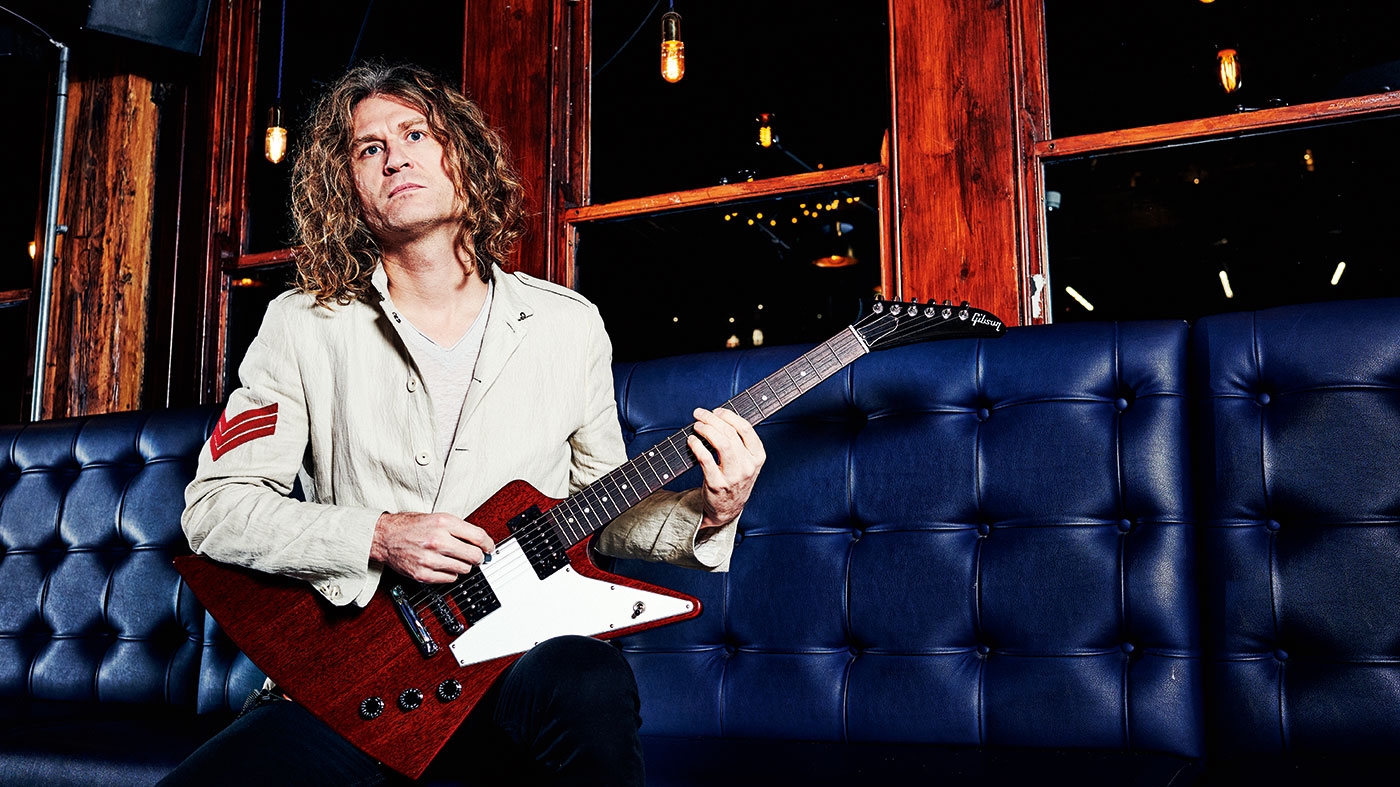
“When I decided to do this album, I thought about all the different styles I liked and the fact that I wanted to include them all,” says Dave Keuning, relaxing backstage before his UK debut at Camden’s Dingwalls.
His first solo release, Prismism, arrives a year and a half on from the announcement that he would be retiring from tour commitments with The Killers, the band he co-founded with frontman Brandon Flowers in 2001, to focus on his family.
“I was going through a lot,” he reflects, before explaining how the new music brought some much-needed light during challenging times. “I love everything from '80s stuff like Prince and the Pet Shop Boys to acoustic music like Hank Williams, so every song ended up feeling different to the next.
Learn more voicings if you want to express different emotions through your guitar
“Actually, a lot of the songs on this new album came from the first time I tried out a certain pedal or keyboard. It’s almost embarrassing how many I haven’t gotten round to after accumulating so many free things over the years, but whenever I finally get to one, I go through all the settings… it’s a good way of coming up with riffs. Things that didn’t sound good dry start sounding great.”
Here, he explains the thinking behind the chords that have made The Killers one of the biggest rock bands of the 21st century and everything he has learned along the way.
Where did your journey in guitar first begin?
“The first thing I bought was by Michael Jackson, then I got into Billy Joel and other '80s music, though it was probably Angus Young who made me want to go out and get a guitar. In my teenage years and feeling more angst, I started listening to AC/DC, Mötley Crüe and Aerosmith. Those bands made me want to play - I needed to learn how to play those songs.
Want all the hottest music and gear news, reviews, deals, features and more, direct to your inbox? Sign up here.
“One year I made a Christmas wish list for my parents with a guitar at the top… they got me everything but that! I don’t think they were quite sure on it yet. So I went round a friend’s house, he had this cheapo Harmony guitar and I bought it for $40 right there because he never played it except for when we were all at his house trying to figure out Smoke On The Water. I wanted to take it home to learn that as well as other songs I could hear in my head.
“After that, I just wanted to learn Walk This Way and all the other classics. I just played for hours and hours, it’s all I’ve done ever since!”
You played in the high-school jazz ensemble and practised sight-reading - did this inform the music at the core of your biggest hits?
“It did have an effect on those songs in a certain regard; there definitely must have been some sort of influence… I know my G7s from my Gmaj7s.
“I remember my teacher, Mr Redman, actually took me to learn from a 20 year-old player in Des Moines who played jazz better than anyone in his state. That’s how I learned about voicings, knowing where to find the different orders you could play notes of a chord. I picked up how you could stay in one area and only move just a finger, but then go up three frets and do something different up there.
“I tried to find as many different flavours because it’s boring to stay at the bottom with D, G, C and E minor. Learn more voicings if you want to express different emotions through your guitar. This teacher was big on playing high up on the neck, which is where Mr Brightside is at with 2nds or 9ths in there.”
Originals
As debut singles go, they don’t come much bigger than that - it’s become an anthem for a generation. What was your thought process behind writing it from a guitar perspective?
“On that song, I’m holding an unusual fingering and then moving the bassline around so just the lowest note is changing. Then in the pre-chorus, it changes position but it’s basically the same thing, so you could take that idea and try writing a song that seems to stay on the same chord but changing the bass note. Or do the opposite!
“Keep the bassline the same and move the chord around… I’m always fishing for something that sounds cool and original, then try to build off that.
I always felt that Seven Nation Army was the last Smoke On The Water - a riff that everyone was playing
“The hardest thing to do right now is come up with something original. I hear a lot of bands trying so frickin’ hard, but I don’t know what the next Smoke On The Water will be because everything’s been done.
“I always felt that Seven Nation Army was the last Smoke On The Water - a riff that everyone was playing. It will probably be the biggest guitar riff for a long time; you get whole soccer crowds singing it! The only way you can find something like that is to keep fishing.”
What kind of bands inspired the more uncommon chords?
“I was in high school learning U2 songs thinking, ‘Oh, he’s just playing a chord here… is that it?’ and slowly I started to understand. When you first start out, there’s just one way to do a G chord, then you start to realise there must be 400 ways. Add in fourths and ninths, and it must go up 1,500 ways. It’s crazy! If you learn them all, it will help with soloing, improvising and being creative.
“My point is that it will make you really familiar with your instrument, like how Hendrix would move around the neck... You want to see the notes before you play them. I learned one of my favourite chords from a Beatles song called Real Love, though I’ve since noticed it’s in loads of other Beatles songs, too; it’s a minor chord with a major seventh.
“If you play it by itself, it sounds haunting and mysterious but on that track, The Beatles used it in such a beautiful way that it stands out. When you learn their songs, you realise how smart they were with theory!
“People underestimate that kind of knowledge; you can’t force a minor/major chord in for the hell of it. You have to make it work in certain areas where it sounds just about right.”
Is sight-reading an aspect modern players often neglect?
“To be honest, I skipped over sight-reading and learned so much faster. I’ve tried twice, once on guitar and once on piano. It gets boring really quickly! You can practise scales and theory without it. I preferred pentatonic and finger exercises over reading music, which felt too slow.
“Most importantly, you need to have an ear. If you have that, you can hear a scale in your head. I used to have piano lessons in college so I started taking that seriously, but the sight-reading felt boring and I decided to apply the knowledge I had from guitar onto keyboards and practise scales that way. So I wouldn’t say I’m pro sight-reading; I’m more about having an ear.”
What’s made you unusual as a guitarist is that you are able to abandon all these technicalities where necessary, as well as embrace them…
“I tend to practise the hell out of scales until they’re second nature to me and then I try not to worry about staying in key, but rather go with what I’m hearing.
“One exception is the intro of If You Say So, which was just me messing around purposefully trying to not know where I was going. There were several takes and we kept the coolest one. I love that kind of thinking - Kurt Cobain would solo but not really care where he was. Every once in a while, it can sound good to do ‘whatever’.”
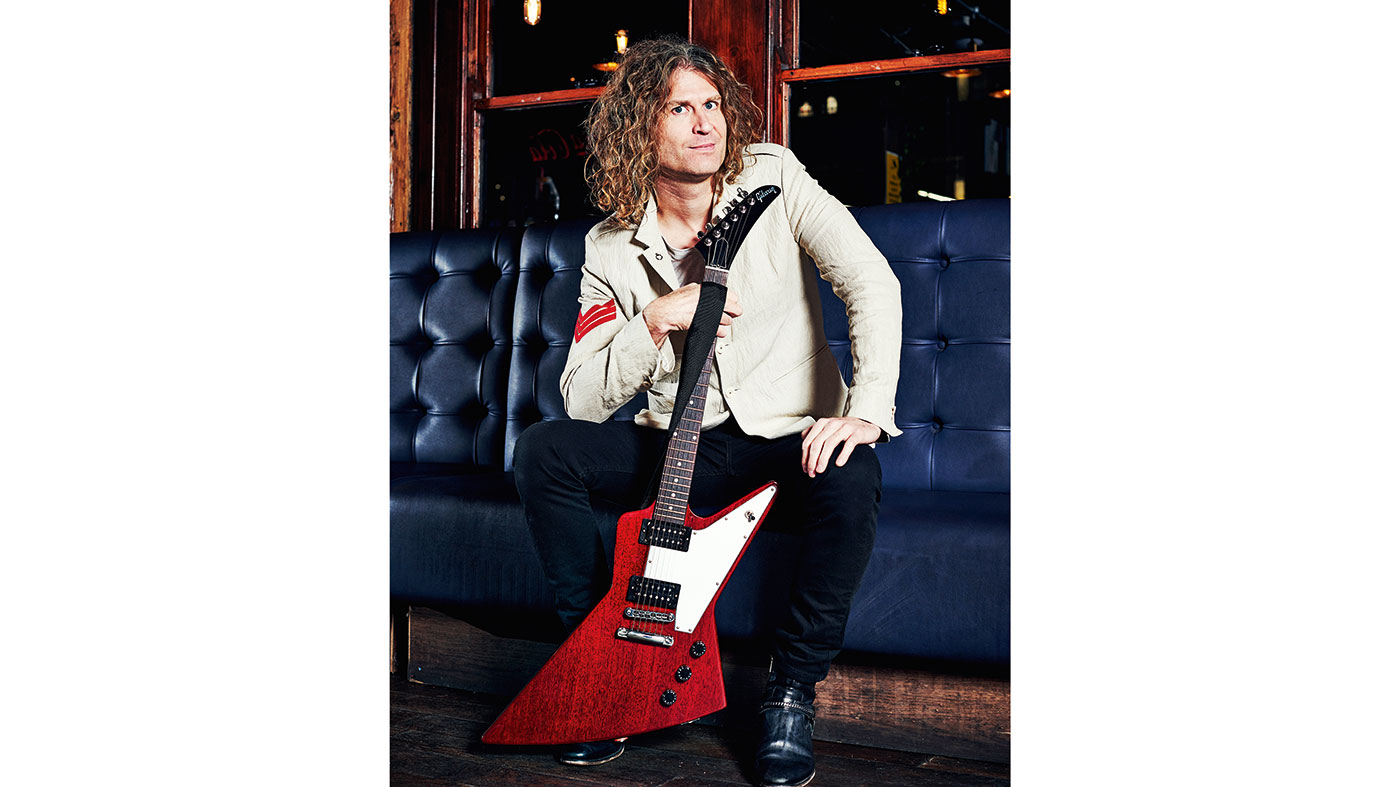
Melody maker
Some of the keyboard parts on tracks from your album like The Night and Broken Clocks seem to mirror guitar phrasing. How do you transfer your ideas from one instrument to the next?
“The instruments are just a way to get a sound or melody out. It starts out in my head first and then I figure it out and learn it on whatever works best. I can go straight to the keys if I want. There are a lot of guitar riffs I want to get out, but I have keyboard riffs, too!
“That was especially fun this time around because I wasn’t really allowed to do that in The Killers because they’re more guitar-only. This time, I could have as much keyboard as I wanted and use presets keyboard players might not necessarily like but sounded fun to my ears.
“I had these ideas, a lot of them piling up that hadn’t been used over the years, on my phone. It was a lot of fun to see them come to life starting out as a voice memo. I’m kinda addicted to that feeling… letting my ideas become songs.”
Gimme Your Heart on the album has some really interesting jazz concepts behind it. What helped you understand the more advanced approach to intervals?
When I was learning there was a book called Intervallic Designs that I got a lot from. I found it used in a garage sale, funnily enough!
“When I was learning, there was a book called Intervallic Designs that I got a lot from. It’s written by Joe Diorio, who was a well-known jazz dude in the '70s. I found it used in a garage sale, funnily enough! It was full of weird little riffs that follow the chord in strange ways.
“Once I started catching on to what he was doing, I started applying that to my own playing instead of learning more. It was really helpful - one book packed with jazz ideas and riffs. That song came from playing around with different fingerings. I have a lot of parts that move around the melody with the chords at the same time. It all just fits together - it was a relatively quick song that got recorded in a day. It’s just a little acoustic love song.”
Then there’s the heavy side of you - Killers songs like Jenny Was A Friend Of Mine, Move Away and All The Pretty Faces ranging between grunge and metal at points…
“Brandon Flowers would agree with you on that, haha! He’s not a huge heavy metal fan, and he always said those were our heavy metal songs. On Sam’s Town, everyone else was working elsewhere in one of the studios and left me alone for too long. I recorded several guitar tracks that made everything sound really heavy.
“It was Metallica, specifically ...And Justice For All, that came out right at the time I was learning. There’s hardly any bass on that album, as people know, it’s all guitar in places and yet it’s a masterpiece. It’s unbelievable, chock-full of the best riffs from start to end. I still try to learn bits in my spare time and I would like to learn every note of it some day. Some of those solos are the best ever!
“Them, Crüe and Smashing Pumpkins were huge for me. Mick Mars always felt like an underrated guitar player… he doesn’t ask for attention, but he has written some of the most memorable riff s in rock. Slash, of course, is one of the greatest and everyone knows that, but Mick Mars is right up there, too, for me. All that whammy bar stuff was amazing.”
Speaking of Smashing Pumpkins, Pretty Faithful is quite alt-rock...
“I was tapping into that influence here - it’s a bit Cherub Rock in how it plays off the Eb. This song, along with I Ruined You, have this wild tuning I made up. It’s a low Eb, followed by an octave up [Eb], then the fourth string is tuned to F# [Gb] and the third string is in unison [Gb], the second is tuned to C# [Db ] and your first string is an F# [Gb]. It’s unusual but still allows for a lot of great riffage on the bottom two strings.
“My pedalboard was a lot bigger with The Killers, but it’s much simpler now - that’s something I picked up from Billy Corgan. Recently he’s been touring with less pedals and he’s right - keep just what you need and you get that pure sound.”
All these things that I’ve strummed
Dave's gear in-depth
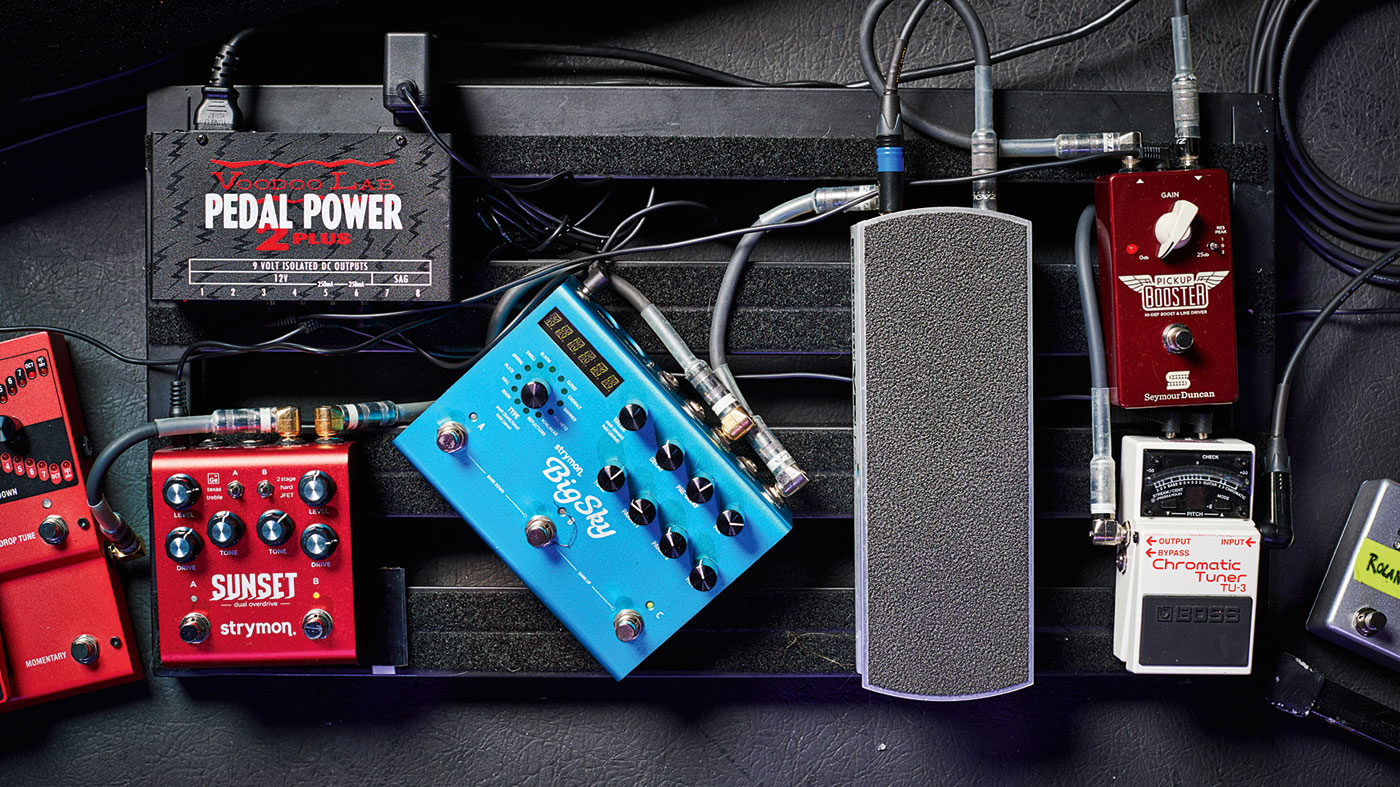
Pedalboard
Strymon BigSky
“I use this for about two or three songs, there’s a setting I made with chorus and delay together. It’s very unique sounding, and I kick it in for The Queen’s Finest, which will be on my next record, and Restless Legs. It’s my quick answer to anything that needs to sound dreamy or shimmery.”
Strymon Sunset Dual Overdrive
“I use this primarily for leads, there are a lot of settings I still need to explore because I’ve just kept it on the first one I liked. It’s really great for solo playing.”
Seymour Duncan Pickup Booster
“This boost is just something my tech recommended. We only use it on certain nights where we need it, on the fly, if the room sounds a certain way. It’s good to adjust whenever we need, almost like an overall EQ.”
Ernie Ball Volume Pedal
“This gets used a lot! I might use it to control that feedback from the hollowbodies on the fly or just turn myself off. When I start an intro, I might rock forward on it. I have the tuner, which kills everything, but sometimes that’s too much. It doesn’t have to be all or nothing!”
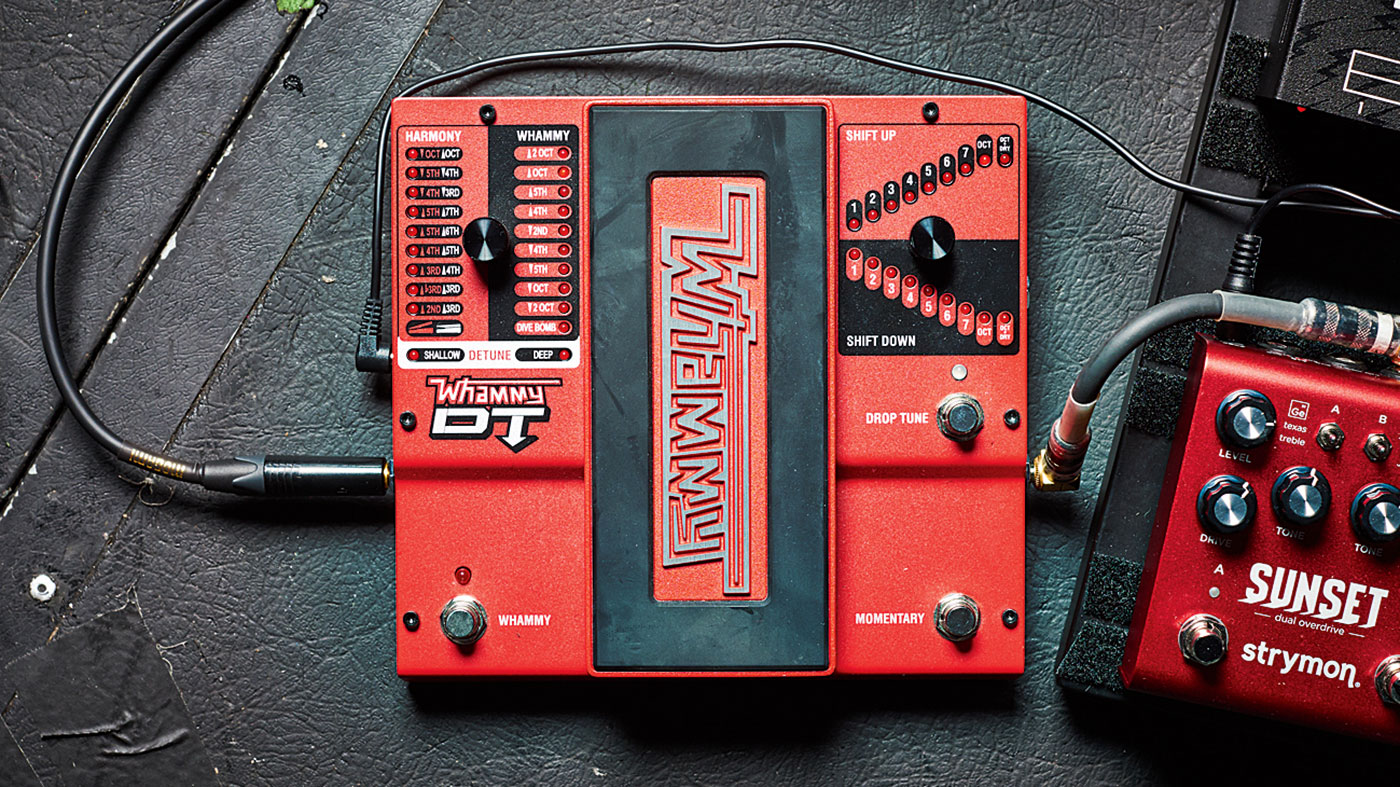
Digitech Whammy DT
“Whammy pedals have been around for a while. I really liked what Tom Morello did with them.
“I use the octave for Boat Accident and I have found this is by far the best one for me. Occasionally, though, I might just kick it in, just for fun!”
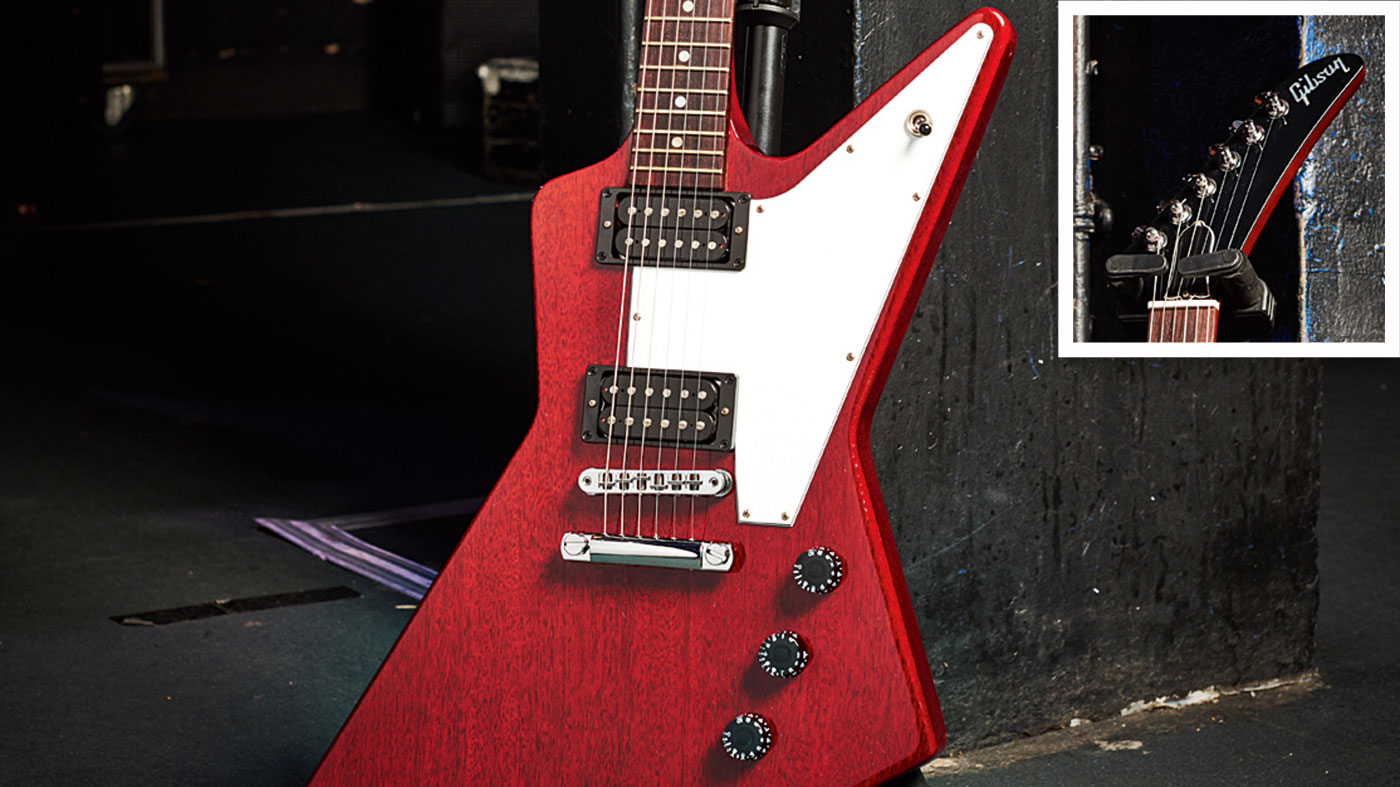
Gibson Explorer
“I decided to leave my old Ibanez Destroyer at home because it’s quite valuable and I didn’t want it to get messed up on the road… plus I love Explorers. I own about three in total and there’s something about having that big piece of wood, which might just help when it comes to tone!
“They look cool too, which doesn’t hurt. It could be the James Hetfield in me, all those hours spent learning songs of Kill ‘Em All like Seek & Destroy. I had a chance to buy a Korina model about 10 years ago, but it was really quite expensive. Now I wish I could go back and get it!”
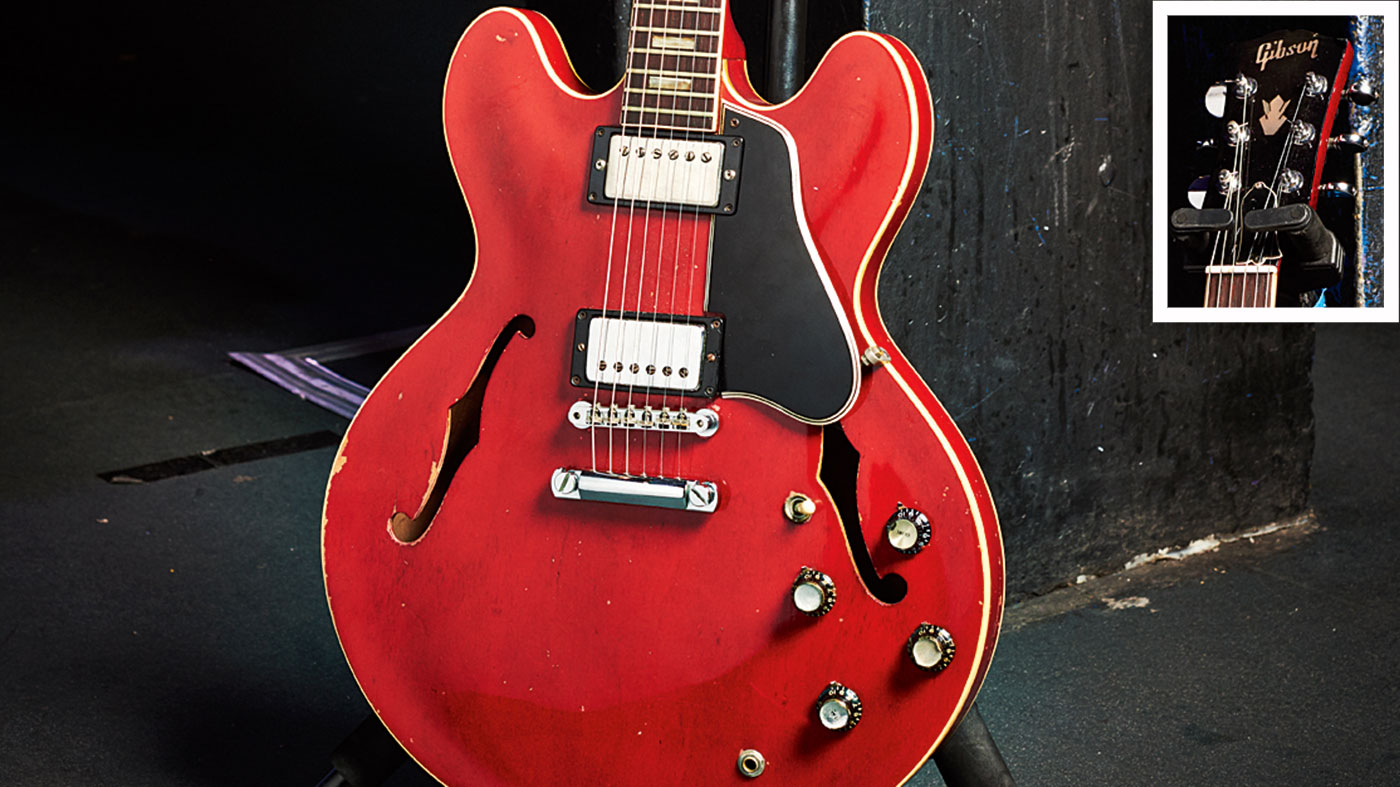
Gibson ES-335
“I own a few 335s including the black one I used to play a lot. I always need a hollow-body with me, some songs just sound so much better using them - for me, it tends to be the cleaner ones, while for the dirtier tones I’ll pick up a solidbody.
“In The Killers, I would use a 335 for solos and on certain stages it wouldn’t be a problem, other nights it would feed back. So I started backing off or moving away from the amps whenever I found myself panicking about the noise. I prefer my 335s a little brighter and louder, with stock pickups kept in.”
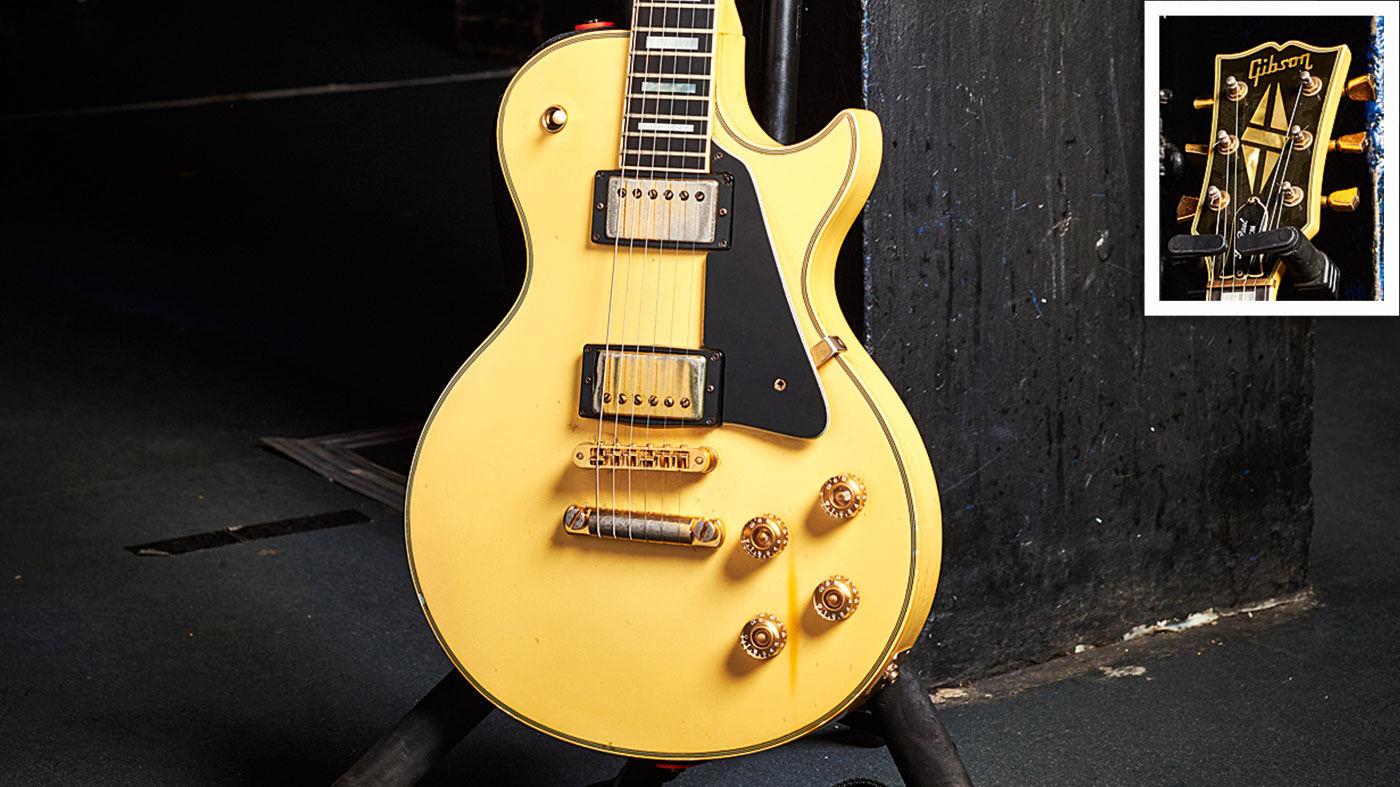
Gibson Les Paul
“I use this for my own tuning - my tech calls it the ‘Keuning tuning’ because it’s the one I made up! I share a Tele with my other guitarist as a backup in case one of us breaks a string, which is also in the same tuning.
“Les Pauls tend to work well for it and this one must be about 10 years old. I have about four or five Les Pauls and 80 guitars in total - which includes five basses, 12 or so acoustics, a mandolin, four or five dobros… it’s about 50 electric guitars and then basically a bunch of other toys on top!”
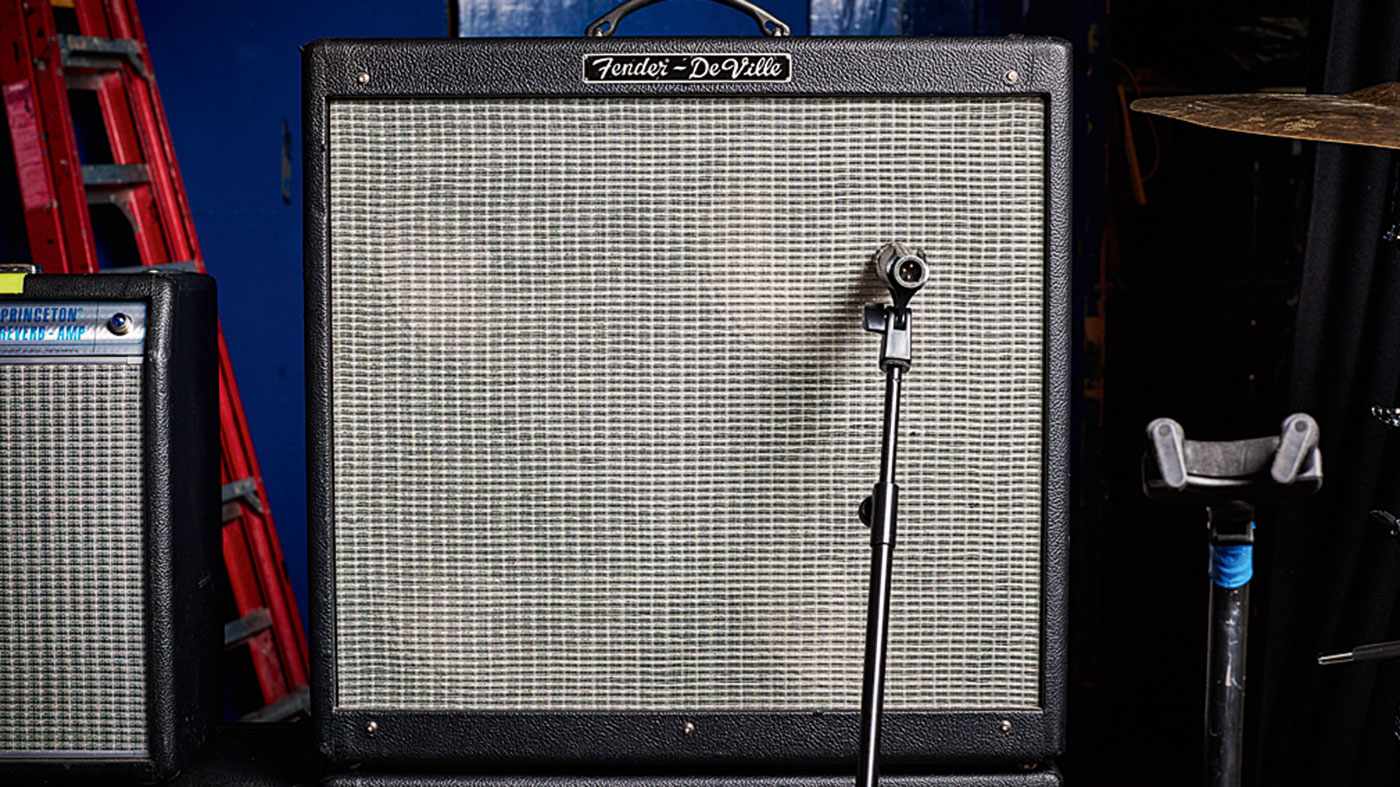
Fender Hot Rod DeVille
“I’m still using Hot Rod DeVilles, I’ve stuck with them since the early days of The Killers. I have a ton of great amps, but this one I keep coming back to because I know exactly how to use it.
“There’s a beautiful clean and then a full dirty or half dirty, which is really convenient. Surprisingly, not a lot of amps offer that! I use it with a Roland Jazz Chorus because that’s the best clean sound out there and very 80s!”
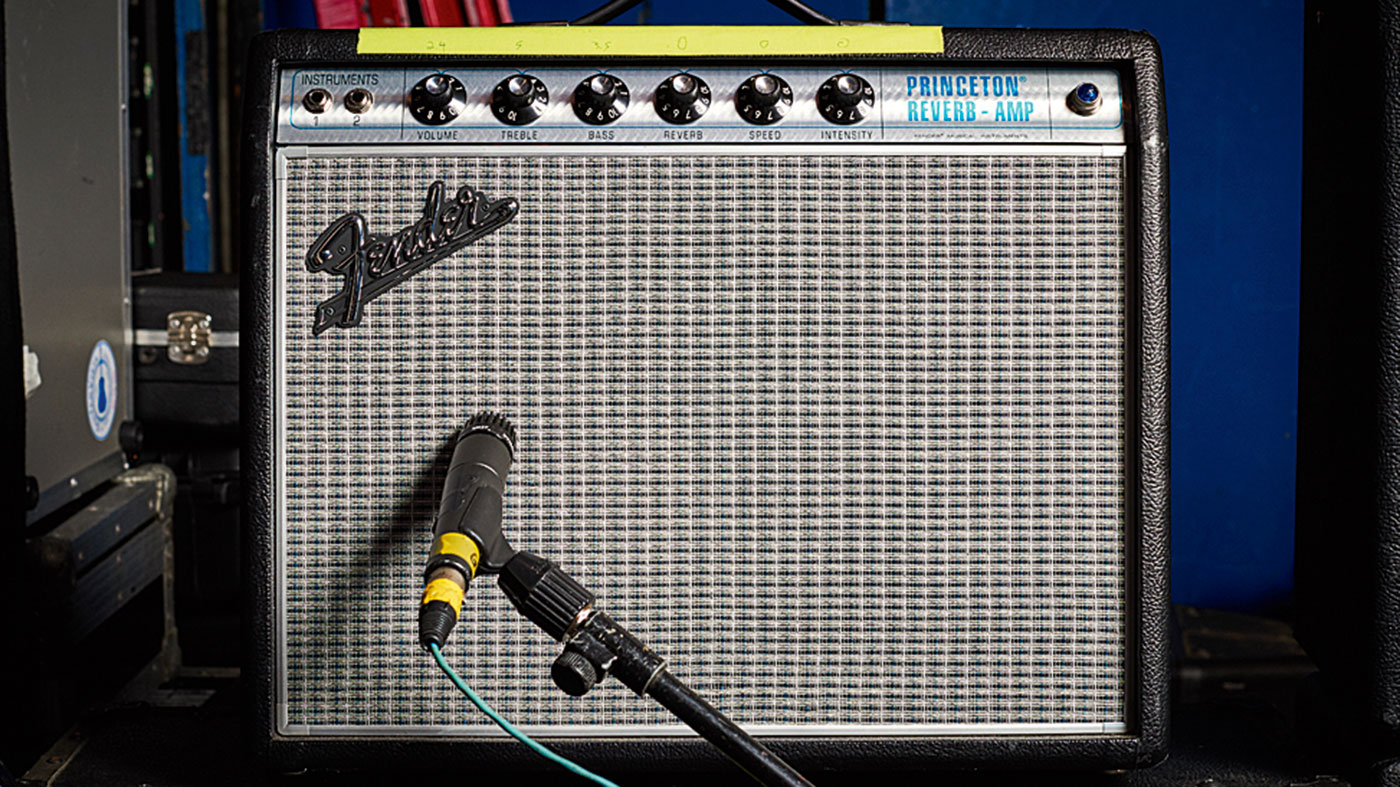
Fender Princeton
“I also have a Princeton, though sometimes I’ll bring my cheaper Mustang amp to save dragging it out.
“It’s full of pre-recorded sounds and I stick with the Princeton setting... those things will really make you think twice about how real digital can sound. Plus, if you want to sound like Judas Priest, you can at the touch of a button!”
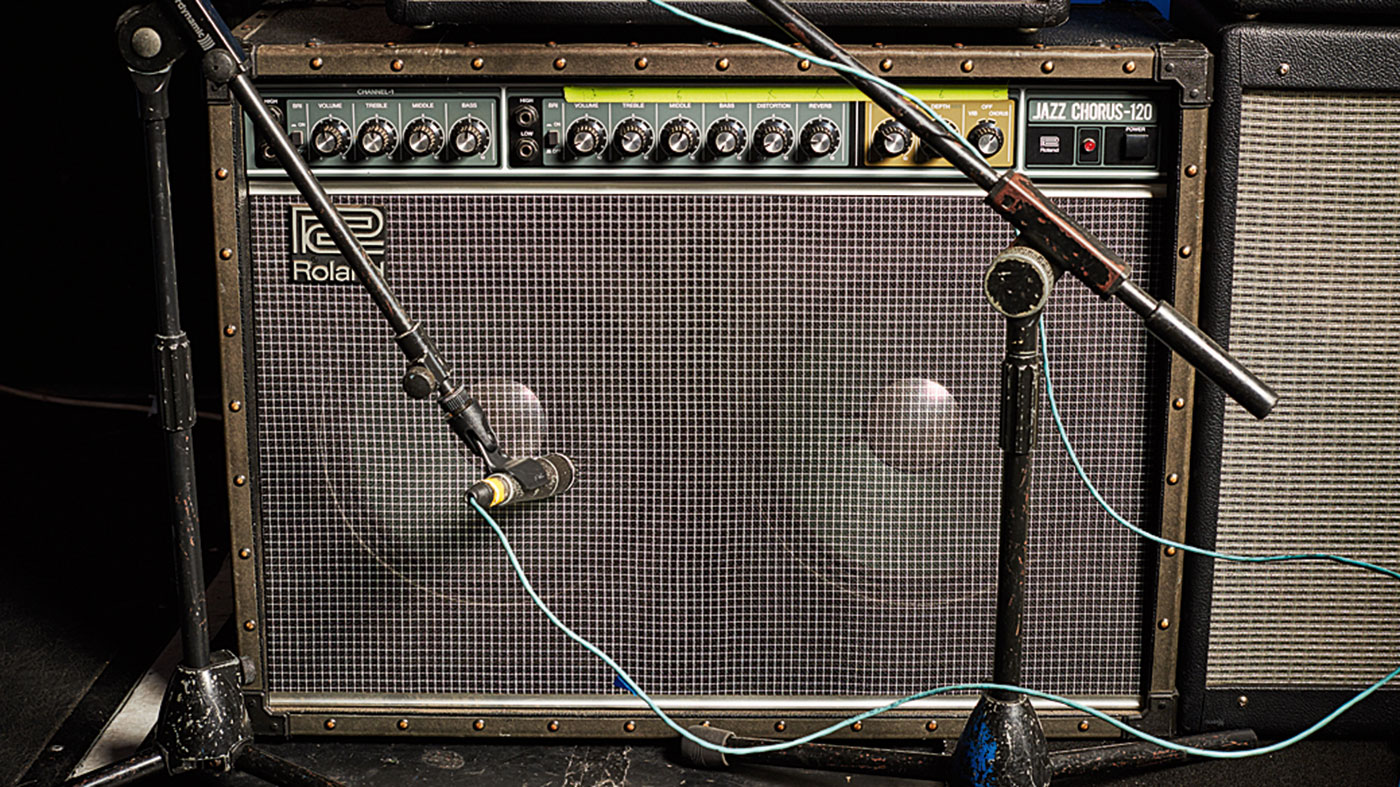
Roland Jazz Chorus
“I’ve always liked the Roland Jazz Chorus, it’s the best clean sound out there and very 80s-ish.”
Amit has been writing for titles like Total Guitar, MusicRadar and Guitar World for over a decade and counts Richie Kotzen, Guthrie Govan and Jeff Beck among his primary influences. He's interviewed everyone from Ozzy Osbourne and Lemmy to Slash and Jimmy Page, and once even traded solos with a member of Slayer on a track released internationally. As a session guitarist, he's played alongside members of Judas Priest and Uriah Heep in London ensemble Metalworks, as well as handling lead guitars for legends like Glen Matlock (Sex Pistols, The Faces) and Stu Hamm (Steve Vai, Joe Satriani, G3).


